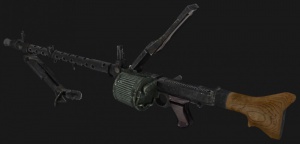Difference between revisions of "Maschinengewehr 34"
(Created page with "{| class="wikitable floatright" | colspan="2" style="text-align: center;" | 300px |- style="background:#666600; color:#fff;" | colspan="2" style="text-...") |
|||
| Line 45: | Line 45: | ||
[[Category:Light Machine Gun]] | [[Category:Light Machine Gun]] | ||
[[Category:Infantry]] | [[Category:Infantry]] | ||
Latest revision as of 07:03, 27 July 2023

| |
| Maschinengewehr 34 (MG 34) | |
| Specifications | |
| Type | General Purpose Machine Gun |
| Caliber | 7.92mm |
| Feed System | 50 Round Drum |
| Muzzle Velocity | 755m/s |
| Rate of Fire | 900 Rounds/Min |
| Maximum Rffective Range | 1000m |
History
The Wehrmacht perceived the role of the machine gun differently than most other nations, which viewed riflemen as the basic unit of infantry warfare with machine-gun support. German doctrine emphasized the machine gun as the basic squad weapon, with the rifle squad supporting it. German tactical theory did not differentiate between light and heavy machine guns. It called for an air-cooled, portable machine gun that could lay down sustained fire. When fitted with a bipod and a box feed device, this gun would be used in the light role; with a tripod and a belt-feed arrangement, the weapon could serve as a heavy machine gun.
Rheinmetall-Borsig tried to design a machine gun to meet these requirements in the late 1920s, the Maschinengewehr (Machine Gun; MG) 30. Its advanced design, with a butt in line with the barrel, wandered less when fired automatically and kept the weapon more accurately on target. The design let operators quickly change the barrel by twisting and removing the butt, then withdrawing the bolt and barrel through the receiver.
The German Army evaluated the MG 30s and, although they did not place an order, requested further development. The gun’s high rate of fire and low weight intrigued the Luftwaffe, which requested the development of an aircraft version in 1932. In response, Rheinmetall-Borsig produced the MG 15.
During the early 1930s, Mauser-Werke and Rheinmetall-Borsig collaborated on a new machine gun. The belt-feed weapon could also use the MG 15’s 75-round double-drum magazine. A hinge connecting the weapons receiver to the rear of the barrel jacket let the receiver swing aside to allow the barrel to be pulled straight from the barrel jacket. The trigger could be squeezed for single shots or automatic fire at a high 900 rounds per minute.
This new weapon, the MG 34, found work in all branches of the German armed services. A wide range of accessories included a periscope that enabled the MG 34 to be fired from below cover and a plethora of mounts for everything from single or twin-gun anti-aircraft defence to fortification installations to vehicles - some were even installed in remote-control mounts atop StuG assault guns. Long-range sights allowed effective fire to reach 3,500 m (3,800 yd) with a tripod.
A heavy MG 34 crew consisted of a commander (usually a NCO), a gunner, and an assistant who usually carried the tripod mount, extra ammunition, and three spare barrels.
Deliveries of the MG 34, the world’s first general-purpose air-cooled machine gun, commenced in 1936 and the gun remained in production until 1945. It was the main infantry-support weapon of the Heer (German Army) during the first half of the World War II and the primary vehicle-mounted machine gun throughout the war.
More MG 34s may have seen service during World War II than any other single model of machine gun. Still, production of this excellent weapon could not match demand. The design and workmanship of the MG 34 required precise, lengthy, and expensive manufacturing processes. With such fine tolerances, the weapon easily succumbed to dust and grit. By late 1940, the Germans recognized that they had to replace the MG 34 with something better suited to large-scale production.